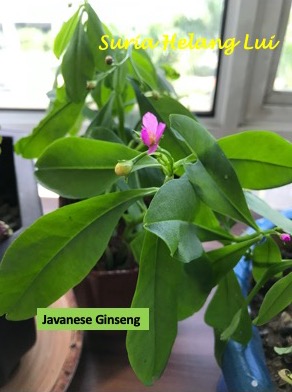Javanese Ginseng – Beauty with Benefits
 Javanese Ginseng (Ginseng Jawa) with its botanical name Talinum paniculatum. I have grown this as an indoor plant although it flourishes when it gets sunlight exposure. I have also planted it in a pot and placed it in my office by a window that receives afternoon sunlight. In this setting, I water it once every couple of days. I use a rich organic soil content with a good amount of peat mixed in the soil. This helps to keep the soil moist but not soggy. It also does well in full sun. and is well suited to our tropical climate. It is an easy to care for plant and doesn’t require daily
Javanese Ginseng (Ginseng Jawa) with its botanical name Talinum paniculatum. I have grown this as an indoor plant although it flourishes when it gets sunlight exposure. I have also planted it in a pot and placed it in my office by a window that receives afternoon sunlight. In this setting, I water it once every couple of days. I use a rich organic soil content with a good amount of peat mixed in the soil. This helps to keep the soil moist but not soggy. It also does well in full sun. and is well suited to our tropical climate. It is an easy to care for plant and doesn’t require daily
watering so if you forget to water it for a couple of days, it should be able to weather your forgetfulness. Just give it a good watering and ensure that the excess can drain out.
This plant produces small pink flowers which adds a burst of colour against its green leaves. I control the plant growth by pruning it which in turns encourages it to “bush-out”. All the leaves and stems that I prune is then turned into a vegetable dish – a great way to utilize it instead of wasting it by trashing it. As the plant matures, the roots will develop tubers. These tubers are morphologically similar to the Korean Ginseng and locally, it is used similar to Korean Ginseng but at a lower price.
Javanese Ginseng leaves may be used raw or cooked. The raw leaves contains oxalic acid similar  to spinach hence when eaten raw, it should be eaten in small quantities. The leaves contain calcium, iron, potassium, magnesium and zinc. It is also a source of powerful natural compounds such as Beta-sitosterol.It can be turned into a simple vegetable soup with garlic, salt and black pepper added to further add flavour. You can also make a simple stir-fry dish and can be used as a spinach replacement. The leaves may also be added to smoothies. I like the taste of the leaves – it has a smooth, creamy flavour without any other strong flavours. They pair well with ingredients like garlic and onion, and flavouring agents such as soy sauce and oyster sauce. Similar to many other leafy vegetables, cooking it can increase the bio-availability of antioxidants and other nutrients.
to spinach hence when eaten raw, it should be eaten in small quantities. The leaves contain calcium, iron, potassium, magnesium and zinc. It is also a source of powerful natural compounds such as Beta-sitosterol.It can be turned into a simple vegetable soup with garlic, salt and black pepper added to further add flavour. You can also make a simple stir-fry dish and can be used as a spinach replacement. The leaves may also be added to smoothies. I like the taste of the leaves – it has a smooth, creamy flavour without any other strong flavours. They pair well with ingredients like garlic and onion, and flavouring agents such as soy sauce and oyster sauce. Similar to many other leafy vegetables, cooking it can increase the bio-availability of antioxidants and other nutrients.
All in all, this plant is easy to plant, has multiple uses and can be used as a decorative plant in your home or garden.

 weather. It can group over 5m tall but you can manage the height by pruning it throughout its life span. Once establish, it doesn’t need to be watered as with our climate, it can survive with just our normal rainfalls. It is a relatively fast grower and its branches spreads out making it a nice tree for providing some shade once it grows tall. However, as I use a good amount of the leaves, I keep the height growth controlled as I prune it about every 3 months or so. With good soil, it doesn’t require any fertilizers though as a normal practice at the farm, we fertilize them twice a year
weather. It can group over 5m tall but you can manage the height by pruning it throughout its life span. Once establish, it doesn’t need to be watered as with our climate, it can survive with just our normal rainfalls. It is a relatively fast grower and its branches spreads out making it a nice tree for providing some shade once it grows tall. However, as I use a good amount of the leaves, I keep the height growth controlled as I prune it about every 3 months or so. With good soil, it doesn’t require any fertilizers though as a normal practice at the farm, we fertilize them twice a year
 meaning of “kelat” but it is the taste that is present in unripen bananas. However, when you use it in cooked dishes, this taste is not present. I guess it is the citrus taste that led it to be name serai as Malaysian knows the lemony taste from the lemongrass or serai in Bahasa Malaysia.
meaning of “kelat” but it is the taste that is present in unripen bananas. However, when you use it in cooked dishes, this taste is not present. I guess it is the citrus taste that led it to be name serai as Malaysian knows the lemony taste from the lemongrass or serai in Bahasa Malaysia.